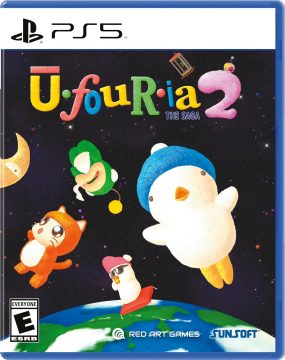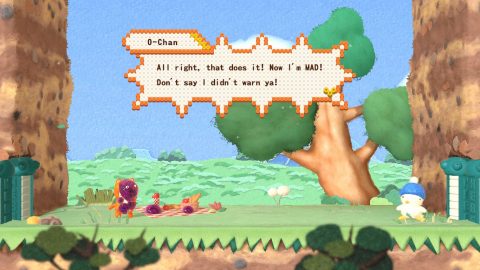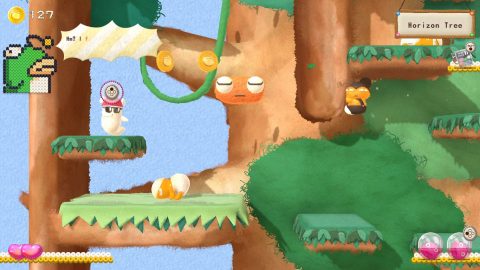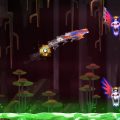
In the 2020s Sunsoft was revived and decided to revamp their old catalogue, starting with licensing the new Blaster Master games to IntiCreates and with an in-house remake of their arcade game Ikki turned into a Vampire Survivors clone. This time, they brought back Ufouria, a game that was originally unreleased outside of Japan and PAL territories.
Ufouria: The Saga 2 AKA Hebereke 2 was announced in 2023 and released the next year, almost 33 years after the original game’s release on the Famicom in Japan. It was developed by a company named Tasto Alpha, that seemingly has only one other game (a fantasy rogue-like deck-builder) under their belt. The title implies a direct continuation, but it actually is a quasi-remake of the original that tells a different story but set in the same areas and following a very similar progression.

Utsujin, the goofy alien invader who was one of three major bosses in the original Hebereke, but became a secondary character almost on par with the main quartet in the follow-up games, is now the instigator of the plot. He falls to Earth (yes, the Ufouria world is referred to as “Earth” this time) in his UFO, bringing with him purple globs with eyes called “Bumyon”. His plan is to subdue the Earthlings with them and cover the whole planet in purple goop to conquer it more easily. Luckily, Hebe the albino penguin was present at the landing, and also found out that his Popoons are able to instantly destroy Utsujin’s Bumyon: he will fight his three friends yet again, free them from the blobs’ influence and ask their help to explore the world and chase the alien down before he can hatch his evil plan.
The original Ufouria was considered a proto-metroidvania, in that the center of the gameplay was to switch characters to use their abilities and special attacks to proceed, uncover new parts of the world and conquer obstacles; Ufouria 2 downplays this, in that the characters have more or less the same abilities and quirks they had in the 1991 game, but the game progression is structured in a different way.
The main hub is Hebe’s house on a tree (little more than a bed, a toilet and some sparse furniture), which has a vending machine under it. Said item shop holds every kind of trinkets, but even in a bizarre world like this one you still need money to buy products. So, Hebe has to pick the coins and chests found everywhere like he’s in a 1990s collect-a-thon platformer, in order to buy stuff that will make his trips easier: from a world map to fast travel, to abilities either universal (crawling, wall climbing) or specific to certain areas (solid clouds, a minecart).
There’s also a secondary collectible item, aluminum cans (who knew these critters were so big on recycling?) scattered around the land: you need certain quantities of them to be able to buy some higher-tier items from the machine, and in turn some of these (like one that gives the ability to spot illusory walls) are useful to pick up even more cans. Other items lead to optional single-screen challenges that grant more coins and cans, opening up even more areas thanks to new buyable items and abilities. The ultimate objective is to reach the four areas furthest to Hebe’s house, find the rocket part hidden in each one, and put them together to reach the extraterrestrial weirdo in outer space for the final confrontation.
Basically, Ufouria 2 can be considered a sort of rogue-lite platformer, given that it is structured around a series of brief trips in short stages that are different every time you set foot in them, ending with a boss battle and the nest of the mother bird Bobodori who will carry us back home (and also ferry us around the world once you have bought back all of her eggs). Not a bad thing in itself, and one should remember that metroidvanias have never been especially popular in Japan despite having their roots there; however, the issue lies in the fact that Ufouria 2 is not so much “rogue”, but really “lite”.
Enemies (all lifted from the first Hebereke) are sparse and mostly wander aimlessly back and forth, bosses are all the same basic template and are all defeated with three head stomps, often in a time shorter than the victory fanfare coming up afterwards; the game is also really generous with life-restoring and life-enhancing items (there’s even a convenient vending machine before every major battle) and there are no really dangerous traps outside of some easily-avoided lava pools (Bumyon are little more than a nuisance, despite being presented as a threat). You can save at any time when you are in the hub area, and everything is also really linear and railroaded, with the pause menu helpfully pointing out where to go and what to do next. Also, sequence breaking is impossible because the guy who restocks the vending machine (the only character exclusive to this game) only provides the plot-important items when the story calls for it, regardless of how many coins and cans you have in your pocket.
The “rogue” part of the gameplay is also limited at best, since stages are not procedurally generated, but are a pool of 3-4 courses for each zone randomly chosen every time; given how many times you will have to revisit them in order to buy all the necessary stuff from the item shop, one will have seen everything the game has to offer two or three hours in. And with how easy and short the stages are, plus how simple it is to stock on cans (optional challenges are ridiculously easy) and gain money by rematching the bosses (our friends included) over and over again, it all feels like busywork after a while, especially since a few important items are hidden behind useless ones that only provide cosmetic enhancements. Obtaining everything from the shop will take no more than six hours, and even that time feels artificially stretched. Not to mention that the character’s abilities (O-Chan’s ice breath, Jennifer’s vomit bombs, etc.) are buyable items this time too, meaning that they aren’t mandatory and only needed to reach cans and chests; but, since these are so easy to find anyway, one could go through the whole game without ever having to use them and only collecting them for achievements.
Still, this game has an undeniable charm. The 1990s pixel sprites have been replaced by 3D models looking like they are made of felt, clay, plastic and other materials used for handcrafts, while the stages seem made with painted cardboard. Everything looks like moving dioramas and some areas like the autumn-colored forests are definitely pretty to look at. The character portraits appearing in the corner of the screen are lifted from the pixelated ones of the old games, but they look like they have been crafted with perler beads, as are the menus. The soundtrack is mostly made of rearranged tracks from the 1991 game but, since those were generally excellent, that’s a good thing, and the new tracks still fit perfectly with the tone and style of the game. And all the dumb noises our quartet make are sure to put a smile on anyone’s face. There’s even a nod to the Western localization of Hebereke with surprise cameos of Bop-Louie and Freeon-Leon, randomly replacing Hebe and O-Chan during the trips back home! Sadly, they haven’t been made playable.
The translation and adaptation in various languages is also quite good and captures very well the game’s goofy Japanese humor and this world’s understated bizarre-ness, in the form of little dialogues during the cutscenes and short chats in the hub area. The characters kept their usual personalities and this comes up in their interactions and the little messages given to the player: Hebe is still a simpleton ditz, O-Chan is still spoiled and theatrical, Sukezaemon is still stoic and meditative, and Jennifer is still a tough manly man.
The Steam version however is quite bare-bones, in that the menu only offers the opportunity to switch languages and quit the game: there’s no options to remap controls, change resolution, music or sound effects volume, not even to cancel the saved game and restart once you’ve completed it.
Ufouria 2 in some respects feels like a missed opportunity: it seems a simplified version of a three decades old game, and what little new content there is (like a ride on a spring-powered rocket while avoiding all kinds of random junk) is so short that one wonders why they haven’t bothered with a direct enhanced remake. In any case, for the fans of this cult classic, it’s still a nice reunion and proof that Sunsoft was right to resurrect these wacky mascots.


